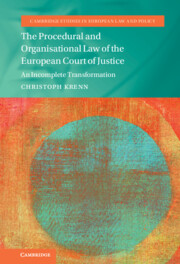Book contents
- The Procedural and Organisational Law of the European Court of Justice
- Cambridge Studies in European Law and Policy
- The Procedural and Organisational Law of the European Court of Justice
- Copyright page
- Contents
- Figures
- Preface
- Acknowledgements
- Table of Cases
- Abbreviations
- 1 Introduction
- 2 What Courts Do
- 3 On the Template of the ICJ
- 4 Luhmann in Luxembourg
- 5 Completing the Transformation
- 6 Conclusion
- Bibliography
- Index
4 - Luhmann in Luxembourg
The Rise of the Rule of Law Model
Published online by Cambridge University Press: 15 September 2022
- The Procedural and Organisational Law of the European Court of Justice
- Cambridge Studies in European Law and Policy
- The Procedural and Organisational Law of the European Court of Justice
- Copyright page
- Contents
- Figures
- Preface
- Acknowledgements
- Table of Cases
- Abbreviations
- 1 Introduction
- 2 What Courts Do
- 3 On the Template of the ICJ
- 4 Luhmann in Luxembourg
- 5 Completing the Transformation
- 6 Conclusion
- Bibliography
- Index
Summary
The third chapter describes how the the re-definition of the ECJ’s role from the 1960s onwards has affected its procedural and organisational law. It is well known that through decisions such as Van Gend en Loos and Costa v ENEL, the ECJ contributed to changing its mandate: from protecting the interests of the Member States to aiming to establish EU law as an autonomous and effective legal system. This chapter tells the story of how the Court’s procedure, organisation and decision-making was adpated to effectively exercise this new role. The chapter shows in detail the vast transformation the Court’s organisation and decision-making has undergone. It explains how the role of the ECJ judge was developed from state representative to neutral expert, how an inner circle of ECJ participants gradually formed that plays a central role for the acceptance and dissemination of the Court’s case law and which procedural mechanisms were devised to make ECJ decision-making more hierarchical in order to foster and maintain consistency in the Court’s case law.
Keywords
- Type
- Chapter
- Information
- The Procedural and Organisational Law of the European Court of JusticeAn Incomplete Transformation, pp. 40 - 101Publisher: Cambridge University PressPrint publication year: 2022

